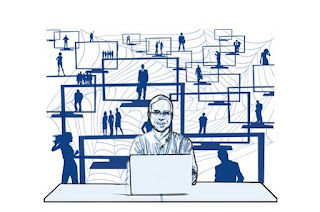The piece below was published on The Evolllution.com and discusses the possibility of a new relationship between academics and HEIs. This disruptive innovation presents academics as vendors for universities and colleges in much the same way that administrative and food services are increasingly outsourced by institutions as a cost-saving measure.
The interested parties of higher education have
in common a complex goal of reducing costs while improving access to quality
education provided in the absence of labour exploitation.
Even so tradition has prioritized the
interests of universities and colleges over those of academics, students and
society, placing an institutional slant on any attempt at improvement.
From this position HEIs have turned to casual labour, technology
and vendor
partnerships in order to fulfil their middleman functions with greater
economy and scale. I am developing
an alternative higher education model that makes use of these institution-oriented
strategies.
To illustrate how consider Josh
Boldt’s observation that cable television
and higher education have complementary interested parties – providers/institutions,
creators/academics, and consumers/students – and that emerging technology and business
models are enabling creators of cable content to connect with price weary consumers
in ways that put pressure on traditional cable providers to offer better pricing
and compensation. In Canada
and the US
one consequence of these developments is the “unbundling” of content.
By analogy, universities and colleges are
in essence licensed to provide students the only for-credit access to higher
education content created by academics. With
decreases in public funding, increases in tuition, poor academic compensation
and the introduction of technology new models are emerging that, like the cable
sector, unbundle
(academic) content from (institutional) providers.
Matt
Reed of Inside Higher Education does not buy Boldt’s analogy. Unlike cable television, higher education
lacks local monopolies and well-known, highly desired content that is unique to
individual creators or providers. There
is a history department in nearly every HEI, though “from the outside,
non-experts (such as prospective students) can’t be expected to know which
American history professor is a life-changer and which is merely competent” and
so “they rely on institutions to do that screening for them.”
I find both to be too conventional in their
thinking. If we are to improve the state
of higher education and better meet the goals of all parties, then what is
needed are models that fundamentally restructure relationships.
The alternative model I propose specifies academics
offer their services within the tradition of a professional social contract, as
do attorneys, physicians, dentists or engineers. Academic expertise would be offered under the
protection and direction of a professional society that affords individuals the
liberty to personally (and collectively) represent their own interests as
“edupreneurs” operating private practices aimed at servicing students from the
traditional to the non-traditional.
With this adjustment universities and colleges
would no longer be burdened by the traditional responsibility of providing income,
benefits, facilities and services to union represented faculty employees. As evinced by the rise in managerial, administrative
and (non-academic) professional personnel the responsibility for this
employer/employee relationship has become a significant public expense in
higher education.
Instead the professional response is
essentially to distribute across a new academic profession responsibility for these
(and
other) typical institutional functions.
This new arrangement affords students and
HEIs the opportunity to enter (service) relationships with professional
academics that improve higher education in ways not possible under the traditional
institutional model assumed by Boldt, Reed and virtually all others.
As an indication of the fundament shift prescribed
by this model consider a professional
translation of these new relationship dynamics in terms of vendor partnerships.
From the point of view of professional academics
traditional
institutions can be seen as vendors for facilities, equipment and services
that academics consume as required by practice management. Under this business model institutions assume
roles already occupied by the wider community.
From the perspective of HEIs academics can be
viewed as vendors whose content and services are consumed as required by institutional
mission.
Focusing on
HEIs, by eliminating the traditional employer/employee relationship institutions
(and academics) are at liberty to exercise greater discretion in the formation
of casual labour relationships, without the immediate imperative of labour
exploitation or expensive administration, management and union representation. Further, without union enforced employment
contracts institutions can respond more effectively to market and economic
changes, exercise greater innovation, and better sustain themselves through vendor
agreements with professional academics.
But consider a potential problem Reed identifies
in Boldt’s argument to unbundle academics from institutions. “If professors have to hawk their pedagogical
wares individually, I see a bifurcation emerging quickly: a few superstars will
do very, very well for themselves, and the overwhelming majority will have to
reduce their activity to a hobby.”
As it happens Reed himself provides an adequate
response. Like cable providers, he notes
that institutions operate as aggregators and screeners of (academic) content suitable
for (student) consumers, and it is precisely this function that enables the
current institutional model and the alternative professional model to unite and
improve the circumstances for all interested parties.
In addition to what would be provided on
the basis of professional criteria, institutions could provide another layer of
academic aggregation and screening. Over
time a system of reciprocity would evolve wherein individual professional
academic reputation is developed as institutions of good repute retain and
endorse their services, while individual academics establish notable public reputations
that can in turn bolster the reputation of any institution that retains their
professional services.
And though there certainly exist legal,
medical and engineering stars no one would suggest, as Reed does, that it is
generally difficult to earn a respectable middle-class living in these professional
fields. I suggest the same would be the
case were higher education to operate as a profession admitting as many
qualified academics as wish to provide the service.









No comments:
Post a Comment